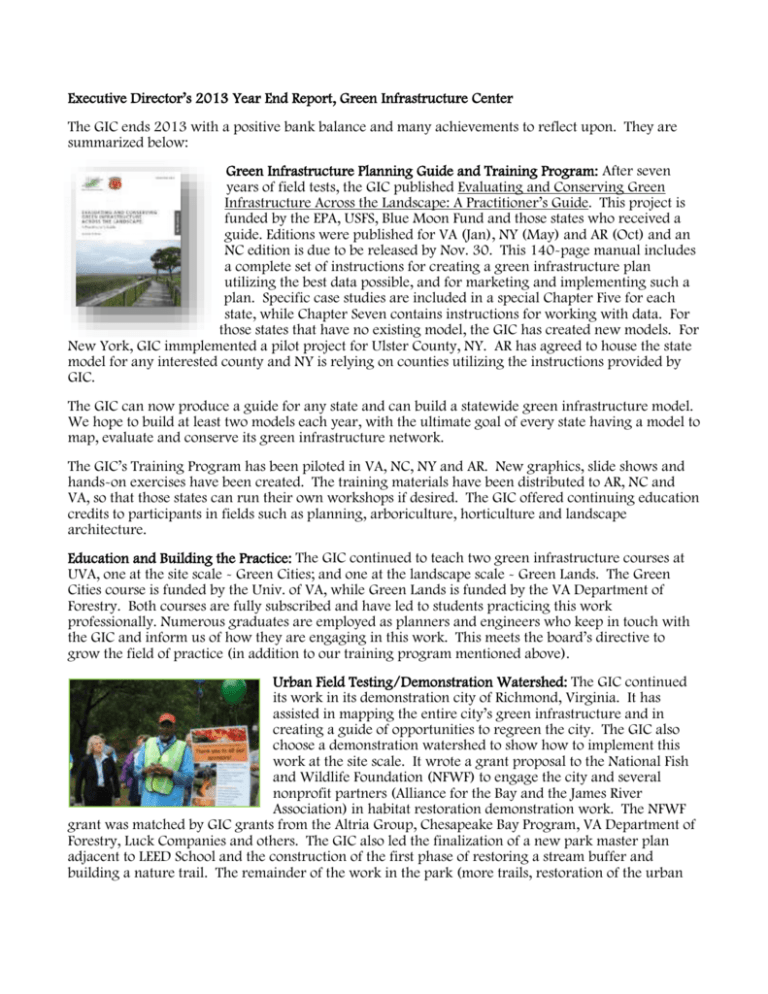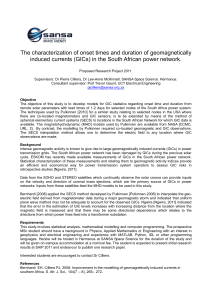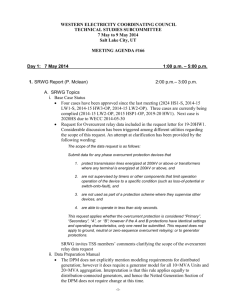Executive Director's 2013 Year End Report, Green Infrastructure
advertisement

Executive Director’s 2013 Year End Report, Green Infrastructure Center The GIC ends 2013 with a positive bank balance and many achievements to reflect upon. They are summarized below: Green Infrastructure Planning Guide and Training Program: After seven years of field tests, the GIC published Evaluating and Conserving Green Infrastructure Across the Landscape: A Practitioner’s Guide. This project is funded by the EPA, USFS, Blue Moon Fund and those states who received a guide. Editions were published for VA (Jan), NY (May) and AR (Oct) and an NC edition is due to be released by Nov. 30. This 140-page manual includes a complete set of instructions for creating a green infrastructure plan utilizing the best data possible, and for marketing and implementing such a plan. Specific case studies are included in a special Chapter Five for each state, while Chapter Seven contains instructions for working with data. For those states that have no existing model, the GIC has created new models. For New York, GIC immplemented a pilot project for Ulster County, NY. AR has agreed to house the state model for any interested county and NY is relying on counties utilizing the instructions provided by GIC. The GIC can now produce a guide for any state and can build a statewide green infrastructure model. We hope to build at least two models each year, with the ultimate goal of every state having a model to map, evaluate and conserve its green infrastructure network. The GIC’s Training Program has been piloted in VA, NC, NY and AR. New graphics, slide shows and hands-on exercises have been created. The training materials have been distributed to AR, NC and VA, so that those states can run their own workshops if desired. The GIC offered continuing education credits to participants in fields such as planning, arboriculture, horticulture and landscape architecture. Education and Building the Practice: The GIC continued to teach two green infrastructure courses at UVA, one at the site scale - Green Cities; and one at the landscape scale - Green Lands. The Green Cities course is funded by the Univ. of VA, while Green Lands is funded by the VA Department of Forestry. Both courses are fully subscribed and have led to students practicing this work professionally. Numerous graduates are employed as planners and engineers who keep in touch with the GIC and inform us of how they are engaging in this work. This meets the board’s directive to grow the field of practice (in addition to our training program mentioned above). Urban Field Testing/Demonstration Watershed: The GIC continued its work in its demonstration city of Richmond, Virginia. It has assisted in mapping the entire city’s green infrastructure and in creating a guide of opportunities to regreen the city. The GIC also choose a demonstration watershed to show how to implement this work at the site scale. It wrote a grant proposal to the National Fish and Wildlife Foundation (NFWF) to engage the city and several nonprofit partners (Alliance for the Bay and the James River Association) in habitat restoration demonstration work. The NFWF grant was matched by GIC grants from the Altria Group, Chesapeake Bay Program, VA Department of Forestry, Luck Companies and others. The GIC also led the finalization of a new park master plan adjacent to LEED School and the construction of the first phase of restoring a stream buffer and building a nature trail. The remainder of the work in the park (more trails, restoration of the urban forest, adding outdoor learning stations, providing trails for walkability), will be completed early in 2014. New projects will also launch in 2014. Watershed Coalition: The GIC received a grant from the EPA’’s Urban Waters’’ Program to build local capacity for watershed management, with which it formed the Upper Goode’’s Creek Watershed Coalition, also in Richmond, VA. The GIC trained members and worked with the community to create a series of strategies to restore watershed health, safety and beauty and to enhance education opportunities. The Coalition is continuing to operate now that the grant has ended and the GIC continues to provide technical support as needed. This work is a model for the city and a sister watershed group has already been formed for the Broad Rock (Lower Goode’s Creek) Watershed. GI Technical Support (Coaching): The GIC is available to support counties and communities to develop their own GI network. It is completing its support for James City County, which will have its own maps by the end of this year and is creating a project for Jersey City, NJ. The GIC also provided feedback to multiple requestors. Messaging: The GIC researched and helped develop key messages for the Forest Service’s Southern Region and is completing a report on best practices for messaging about land conversion, the impact of invasive species and pests and fire readiness. The GIC conducted focus groups in TX, FL, NC and VA, and will release the final report on this work in December. Outreach: The GIC provided 16 training workshops and webinars and keynoted several state forestry conferences, such as in PA and GA; it also gave numerous lectures on GI planning. New graphics from the training program have been incorporated into the training and the graphics and other materials have been greatly improved. The GIC is scheduled for more webinars (e.g. the U.S. EPA) and conference keynote sessions (e.g. MI and SC) in 2014 and will continue to launch training workshops. Now that workshops have been successfully piloted in multiple states, the GIC is able to offer them for a fee. This fee can be utilized to support GIC’’s work. The GIC created a new Services brochure to market its skills and technical assistance offerings. Strategic Plan: The GIC completed its three year strategic plan and will be building new grant proposals to meet the “enterprise projects” proposed in areas such as climate change adaptation and healthy communities. The GIC looks forward to expanding its reach in 2014 with those new materials, research and outreach tools already in place or underway. GIC Capacity: The GIC expanded staffing in 2013 by adding a part-time community watershed coordinator, Mack Brown, in Richmond and a 2/3 time Community Watershed Planner, Tim Gaylord, to its Charlottesville office. They joined the previous staff of Executive Director Karen Firehock, GIS Analyst and Modeler Charles Kline and GIC Accountant Cindi Johnson. The GIC also continued to work with partners to effectively achieve its goals, such as statewide nonprofit organizations, counties and states. The GIC believes that building local capacity to do this work is the best way to achieve long-term sustainability for GI planning and ultimately protect and restore healthy habitat for wildlife and people - at any scale.






